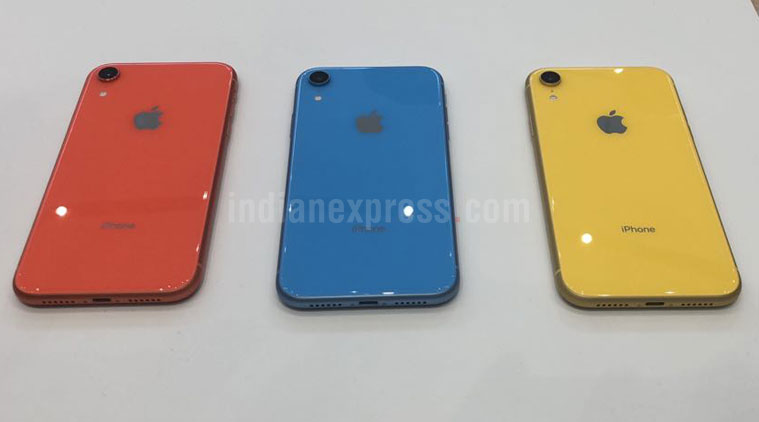 Apple’s iPhone XR is what helped the brand dominate the fourth quarter, according to numbers. (Image source: Nandagopal Rajan/Indian Express)
Apple’s iPhone XR is what helped the brand dominate the fourth quarter, according to numbers. (Image source: Nandagopal Rajan/Indian Express)
OnePlus might be the overall leader in the premium segment (above Rs 30,000) in India, but it was the year-old Apple iPhone XR that remained the best-seller when it came to the ultra-premium segment (Rs 45,000 and above). This was corroborated in numbers and observations made by research firms Counterpoint and Canalys in their respective reports for India’s smartphone market in the fourth quarter (2019) and all of 2019.
Numbers from Counterpoint and Canalys showed that the 2018 iPhone XR was ahead of both Samsung’s Galaxy S10 Plus and OnePlus 7 Pro, both of which launched in 2019.
The iPhone XR’s success is particularly interesting because it comes with a single camera, a lower resolution LCD display, compared to these two phones, which offer triple cameras and bigger AMOLED displays. But clearly the phone appealed to consumers as a much more valuable proposition and helped boost the numbers for Apple. More importantly, the iPhone XR retained momentum throughout the year, going by analyst observations.
“One of the reasons for the surge in sales was price correction in iPhone XR, (discount of ~$250), during the second quarter of the year after which it became the best selling iPhone within Apple portfolio for two successive quarters (Q2 2019, Q3 2019), a slot which older generation iPhones used to capture in India,” Counterpoint Research’s associate director Tarun Pathak told
Read our weekly Apple blog here, where we talk about how Cupertino needs to solve the battery problem.
He also pointed out that Apple started assembling the iPhone XR in India locally, which again saved duty. In October, it was reported that Apple had started assembling the phone locally in Chennai with its partner Foxconn.
Still wondering if the iPhone XR is worth the price? Read our review here. Or if you want the iPhone 11, read our review here.
“In Q4-2019, Apple bounced back with an upsurge in demand for iPhone XR and iPhone 11. iPhone XR had the highest shipments and captured about 50 per cent of overall iPhone model-shipments in India,” Canalys’ Madhumita Chaudhary told indianexpress.com in an email.
“The newly launched iPhone 11 and 11 Pro together accounted for over 30 of the overall model shipments,” she added.
Express Tech is now on Telegram. Click here to join our channel (@expresstechie) and stay updated with the latest tech news
Regarding the iPhone 11, which was the most affordable in the new series, Chaudhary said it was “well-received during the launch with its smart pricing strategy, which was at a much lower price point than its predecessor iPhone XR.”
Apple dominates in the above $500 segment
Apple’s fourth quarter in India was its best ever, according to numbers posted by Canalys, with the company hitting nearly 925,000 shipments in the quarter. It had close to 2 million shipments in the course of the year.
Research firm International Data Corporation (IDC) in its report said that Apple reached a record 75.6 per cent market share in the above $500 segment for the fourth quarter, while for all of 2019 it was ahead of Samsung with a market share of 47.4 per cent.
While local manufacturing and festive offers and discounts all played a role in boosting numbers, Apple’s brand value remained intact, which continues to drive the brand’s success.
“Apple managed to bring down the device cost without compromising on the brand value, which in itself is crucial because in a country such as India, Apple has solid brand equity and consumers are willing to pay. At this stage the company has struck a right balance with price and perceived brand value,” she pointed out.
OnePlus 7T Pro or the Samsung Galaxy S10+? Read our reviews to know which is the better pick
She also noted that the iPhone 11’s price strategy made it a powerful alternative to both the Samsung or OnePlus flagships. The new iPhone 11 launched in India at Rs 64,900 which was much lower than the iPhone XR’s price of nearly Rs 75,000 back in 2018.
According to Counterpoint, for all of 2019, Apple was the fastest growing premium smartphone brand with 41 per cent year-on-year growth. Samsung was close with its more expensive Galaxy S10+ doing well in the market.
For OnePlus, which launched the OnePlus 7 Pro this year with a more premium price tag starting at Rs 45,000, and followed it with OnePlus 7T later on, there’s still some way to go before it can challenge these two giants. “The ultra premium segment, which is above Rs 45,000 is still driven by Apple and Samsung. OnePlus needs to push aggressively in that segment to break the duopoly of Apple and Samsung,” noted Pathak.
